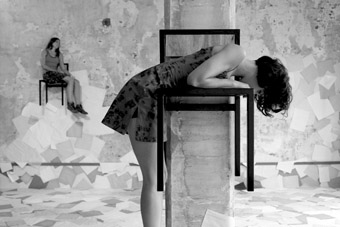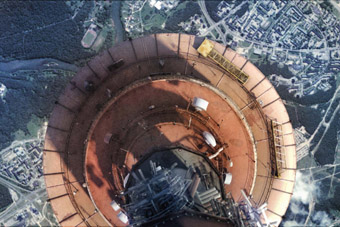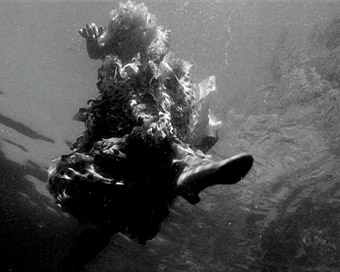 |
Cinetica |
While the ash cloud only succeeded in postponing program from Iceland, Hungary and Portugal to a rescheduled autumn event, a sense of generational handover pervaded every aspect of the festival. Work by a new crop of artists, filtering into mainstream programming, included the shifting subjectivity of Marina Tsartsara’s green-and-gold, meadow-set Through (2009) and the microscopic movement world of Fiona Geilinger’s charcoal-effect Pinstripe (2009). There were excursions into Second Life, the sporadic appearance of mobile phone pixillation—as distinctive as film grain—and the unvarnished immediacy of a YouTube aesthetic mixed with high-end finish from established, international ‘names’, such as Cordelia Beresford’s Sydney-set Night Shift (2009) and Marlene Millar and Philip Szporer’s spotlit, fragile Falling (2009). With additional links to the Watching Dance conference, held in parallel in Manchester, three home-set presentations on “Framing Motion” fielded Kate Sicchio’s notion of programmer as choreographer, composing pixels in frames within frames; Vida Midgelow on the politics of documentation, casting improvised movement as a process of disappearance; and Liverpool-based Gina Czarnecki’s outlining of her professional evolution from painting to film and then video, culminating in a slowed moment—captured in green-tinged night-vision—of close-in, facial transformation, from recent work Spintex (2009).
 |
Synchronisation |
Addressing issues at the heart of Moves’ identity, and reflecting widespread groundswell of artform shift, festival co-curator Gitta Wigro chaired a roundtable discussion of “Screendance on the Verge,” highlighting the dangers of artificial distinctions imposed around a self-titled niche. Pauline Brooks, of Liverpool John Moores University, outlined her role as facilitator for an emerging generation of screen-literate artists, while Claudia Kappenberg, head of the AHRC Network for Discourse and Publication in Screendance, emphasised the need for a body of informed writing within the field, also setting out her involvement as co-curator in the recent artist-led What If...Festival. Calling attention to the increase in hybridity across all forms, Jamie Watton, Director of South East Dance Agency, also noted the end of the producer-led era, acknowledging artists’ role at the centre of the creative process, with this shift reflected in a change of terminology from ‘screendance’ to the more open-ended ‘screen-based work.’
 |
River Dreams |
In a particularly strong documentary-influenced programme, the deceptively simple surface gaze of Nick May and Ben Holland’s Food Chain (2009) surveyed Escher-like, multi-angled conveyer belts, the repetitive gestural unison of eye-deadened production line workers, and a single, flailing onion. Bronwen Buckeridge’s camera in Lacuna Cut (2009), closed in on the ritual application of mask-like face paint, abstracting to a red spot; a pink stick; encroaching expanses of blue, white and gold. Against the static foreground of a roughly textured field, archive wedding photos and architectural structures in Jonathan Franco’s Living Land (2008) momentarily flash up, and are gone, and in Carlos Amelia’s powerfully understated Tierra Y Pan (2008), slow, outward camera motion locates a dog tied to a post within a wind-whipped, desert-set horizon line, as focus gradually recedes from episodic and unsparing narrative detail, revealing in turn a heavily pregnant woman, a doctor’s bag, a spade.
Near the festival’s end, Daniel Bird’s contextualisation of Armenian filmmaker Sergei Paradjanov’s “dynamic, frenetic” symbolic language in The Colour of Pomegranates (1968) cast a long shadow across scheduling, identifiable in Anne Harild’s Morandi Room (2008), with front-on camera perspective catching the surface sheen of proliferating, differingly-shaped vessels, and the shifting gleams of light on rising water-level. Paradjavnov’s legacy was also evident in the snowset tableau of Galina Myznikova and Sergey Provorov’s Despair (2008) and in the poetic economy of a young female face in greyscale, close-in, slowed-motion, shaking blade-like wettened hair in Myznikova’s The Girl—Helicopter (2008).
Sited throughout the Bluecoat, installations included the linked remote screens of Charlotte Gould and Paul Sermon’s al fresco Urban Picnic, codes for mobile phone downloads created by Salford University students, and the rich visual arrangement of Sara Bjärland’s monochrome dandelion seeds in 80 Movements (2008), with a series of carefully composed slides appearing at rhythmically projected intervals. Across the four-frame line-up of Katrina McPherson and Simon Fildes’ Crux (2009), a quartet of male boulderers—captured in the detail of white-taped fingers, a beaded bracelet, a circular tattoo—attempt the unfakeable physical engagement of sheer exterior ascent, with slow eye scans and sudden drops, reaches for stone ledges and rock shelf and hand holds and finger crevices also recorded in the linear verticality of Laban-notated scores. Elsewhere, a single participant is guided through an immersive audiovisual experience by the intermittent touch of an unseen hand in Clara Garcia Fraile and Sam Pearson’s When We Meet Again, and left to re-enter real space alone with a smile and the gift of a single strawberry.
Viewed from within a landscape of hybridisation and boundary-crossings, Moves is looking like a festival whose time may just have come. Emerging into early evening light, the sky above Liverpool is a bright, clear blue, and not a cloud in sight.
Moves10, Bluecoat Arts Centre, Liverpool & venues throughout the north-west, UK, April 21-25
RealTime issue #97 June-July 2010 pg. 25
© Chirstinn Whyte; for permission to reproduce apply to [email protected]








 back
back